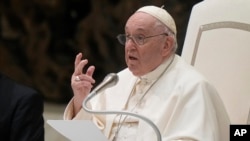Pope Francis starts a trip on Tuesday to two fragile African nations often forgotten by the world, where protracted conflicts have left millions of refugees and displaced people grappling with hunger.
The Jan. 31-Feb 5 visit to Democratic Republic of Congo (DRC) and South Sudan, takes the 86-year-old pope to places where Catholics make up about half of the populations and where the Church is a key player in health and educational systems as well as in democracy-building efforts.
The trip was scheduled to take place last July but was postponed because Francis was suffering a flare-up of a chronic knee ailment. He still uses a wheelchair and cane but his knee has improved significantly.
Both countries are rich in natural resources — DRC in minerals and South Sudan in oil — but beset with poverty and strife.
DRC, which is the second-largest country in Africa and has a population of about 90 million, is getting its first visit by a pope since John Paul II travelled there in 1985, when it was known as Zaire.
Francis had planned to visit the eastern city of Goma but that stop was scrapped following the resurgence of fighting between the army and the M23 rebel group in the area where Italy's ambassador, his bodyguard and driver were killed in an ambush in 2021.
Francis will stay in the capital, Kinshasa, but will meet there with victims of violence from the east.
"Congo is a moral emergency that cannot be ignored," the Vatican's ambassador to DRC, Archbishop Ettore Balestrero, told Reuters.
According to the U.N. World Food Program, 26 million people in the DRC face severe hunger.
The country's 45 million-strong Catholic Church has a long history of promoting democracy and, as the pope arrives, it is gearing up to monitor elections scheduled for December.
"Our hope for the Congo is that this visit will reinforce the Church's engagement in support of the electoral process," said Britain's ambassador to the Vatican, Christ Trott, who spent many years as a diplomat in Africa.
DRC is getting its first visit by a pope since John Paul II travelled there in 1985, when it still was known as Zaire.
Unprecedented joint pilgrimage
The trip takes on an unprecedented nature on Friday when the pope leaves Kinshasa for South Sudan's capital, Juba.
That leg is being made with the Archbishop of Canterbury, Justin Welby and the Moderator of the General Assembly of the Church of Scotland, Iain Greenshields.
They represent the Christian make-up of the world's youngest country, which gained independence in 2011 from predominantly Muslim Sudan after decades of conflict and has a population of around 11 million.
"This will be a historic visit," Welby said. "After centuries of division, leaders of three different parts of [Christianity] are coming together in an unprecedented way."
Two years after independence, conflict erupted when forces loyal to President Salva Kiir clashed with those loyal to Vice President Riek Machar, who is from a different ethnic group. The bloodshed spiraled into a civil war that killed 400,000 people.
A 2018 deal stopped the worst of the fighting, but parts of the agreement, including the deployment of a re-unified national army, have not yet been implemented.
There are 2.2 million internally displaced people in South Sudan and another 2.3 million have fled the country as refugees, according to the United Nations, which has praised the Catholic Church as a "powerful and active force in building peace and reconciliation in conflict-torn regions."
In one of the most remarkable gestures since his papacy began in 2013, Francis knelt to kiss the feet of South Sudan's previously warring leaders during a retreat at the Vatican in April 2019, urging them not to return to civil war.
Trott, a former ambassador in South Sudan, said he hoped the three Churchmen can convince political leaders to "fulfil the promise of the independence movement."










